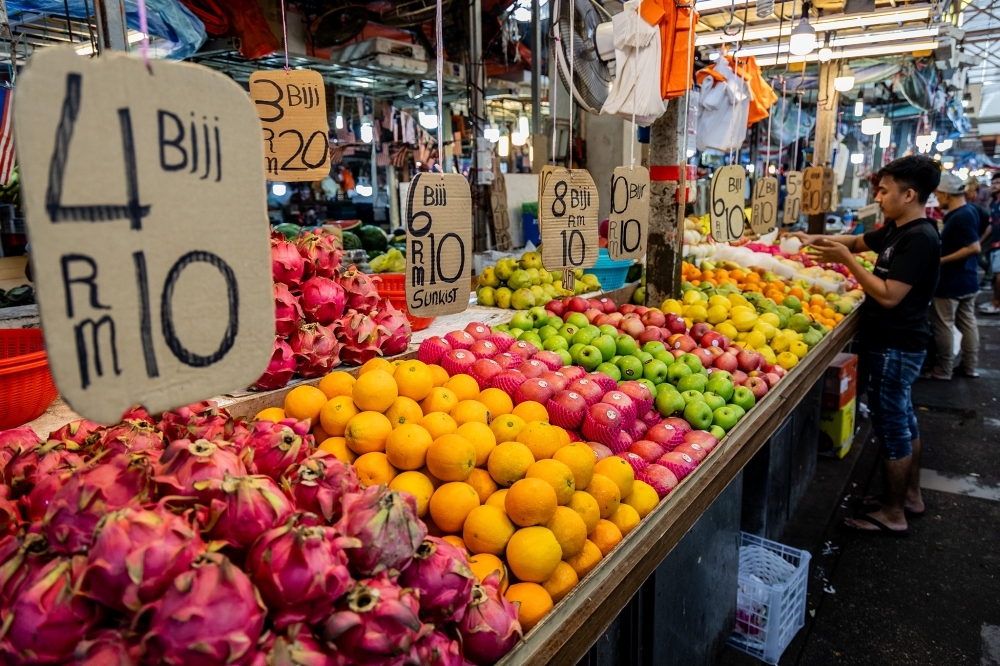
Imported fruits getting too pricey? Here are local alternatives that outshine them in nutrition

Fruits displayed for sale at the Chow Kit market in Kuala Lumpur June 25, 2025. — Picture by Firdaus Latif
Monday, 30 Jun 2025 7:00 AM MYT
KUALA LUMPUR, June 30 — With the revised and expanded Sales and Service Tax (SST) on imported goods set to take effect next month, Malaysians are bracing for a significant increase in the prices of imported fruits.
Earlier this month, the government announced a targeted SST review that will take effect on July 1, 2025, which will include imported fruits, except apples and oranges.
With the new taxes in place, consumers may find imported fruits like berries, grapes, and cherries becoming more expensive.
However, Malaysia has a diverse range of local fruits that not only rival but often surpass their imported counterparts in nutritional value.
As a result, budget-conscious Malaysians may turn to these local alternatives, which offer both flavour and nutrition.
Local fruits that beat imports
While enjoying a diverse array of fruits from around the world is certainly a delightful experience, it’s equally important to recognise and appreciate the worthy options found locally.
Here’s a list of local fruits that can be a great alternative to their imported counterparts in terms of nutrition and minerals:
Apples vs guava
While apples are often branded as a healthy fruit for their fibre content and low-calorie count, guava steps up with even higher fibre and an impressive vitamin C boost, offering antioxidant benefits that surpass those of apples.
For comparison, 100g of guava contains 5.4g of dietary fibre compared to an apple, which only has 2.4g.
The same amount of guava also has an impressive 228mg of vitamin C, while apple only has 4.6mg.
Blueberries vs mangosteen
Known for their antioxidant properties, blueberries are often sought after for their antioxidant content.
Mangosteen, with its potent xanthones, offers similar antioxidant benefits plus additional anti-inflammatory effects.
Research suggests that xanthones offer a range of potential health benefits, including anti-cancer, and antimicrobial properties.
Grapes vs langsat
Grapes are a popular source of antioxidants and Vitamin K, responsible for bone health and the healing of injuries.
Langsat, on the other hand, offers similar benefits, plus it contains B vitamins that are crucial for energy production.
Strawberries vs rambutan
Both these fruits are rich in vitamin C and antioxidants.
Rambutan also offers vitamin A and other minerals such as manganese, copper, potassium, calcium, and magnesium.
Orange vs papaya
Papaya is a great substitute for oranges when it comes to vitamin C content.
For comparison, 100g of papaya provides over 60mg of vitamin C, which is about 20 per cent higher than an equivalent serving of orange.

Malaysia boasts a variety of local fruits that offer superior nutrition and minerals compared to their imported counterparts. — Picture by Firdaus Latif
Do imported fruits have higher nutritional value?
Despite a common perception that imported fruits are more premium, largely due to their exotic appeal and higher price tags, local fruits may often be a fresher alternative to their imported counterparts.
The perceived superiority of imported fruits is often linked to branding and prestige, overlooking key aspects such as freshness and nutritional value in homegrown fruits.
Additionally, imported fruits, by nature of their long journey from their country of origin, must go through rigorous logistical processes to reach Malaysian shelves.
These processes often include treatments like waxing and deep freezing to stretch shelf life.
For instance, apples and citrus fruits are sometimes coated with a thin layer of wax to preserve moisture and maintain their appearance during the multi-week shipping transit, haulage, and sorting before they hit the shelves.
Such processes and the lengthy journey can often impact their taste, texture or even nutritional value.
In contrast, Malaysian fruits, being locally grown and harvested, offer greater freshness.
Often picked at peak ripeness, the short supply chain from local farms to markets means that they are less likely to undergo any preservation processes, making them an even healthier option.
Mangosteen , langsat and langsat are only available when in season, about 4-5 months in a year.
ReplyDeletePrice gouging is common, due to limited seasonal availability.
I'm not disparaging local fruits , but the fact is we need a wide variety of supply.
This is an Anwar Madani concocted problem.
Granted some imported fruits are in the " luxury" category, but a great many are not.